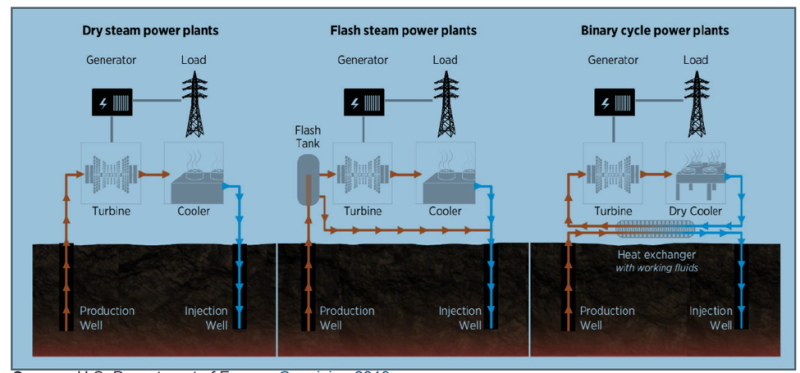Of the 2,558 MW of geothermal power plant capacity currently operating in the US, 1,826 MW of capacity is from steam-powered plants and 731 MW of capacity is from binary-cycle powered plants. But the balance is shifting, according to the US Energy Information Administration (EIA).
Utility-scale geothermal power plants in the US use either steam power or a binary cycle to generate electricity. A little more than 70% of the country’s current geothermal capacity was built before the year 2000, using mostly steam-powered technology. However, of the 735 MW of capacity built since the turn of the century, nearly 90% is binary-cycle capacity.
A Matter of Flexibility?
The reason for the shift from steam to binary-cycle power may be a matter of flexibility. Geothermal plants are geographically limited to areas with hydrothermal resources that occur naturally in underground reservoirs of steam and hot water. The steam and hot water can be used for power generation by drilling a well into the reservoir and piping them to the surface. The hot water or steam powers a turbine, which generates electricity. The type of geothermal power plant technology used depends on the characteristics of the reservoir.
Steam-powered technology uses steam directly from a geothermal well to spin a turbine and generate electricity. Binary-cycle geothermal power plants use a heat exchanger to take heat from the hot water in the well to heat a secondary fluid that then spins a turbine.
Currently all of the geothermal plants in the US are located in the western part of the country, mostly in California or Nevada. California has 91% of the country’s steam-powered capacity, and 65% of binary-cycle capacity is found in Nevada.
There are two types of steam-powered geothermal plants: dry steam and flash. A dry-steam plant operates in reservoirs that primarily produce steam at the surface of the well. The steam produced from the reservoir turns the turbines’ blades to generate power, and as the steam cools, it is reinjected into the reservoir as water.
A flash plant operates in reservoirs that produce a mix of steam and hot water. The steam in the reservoir is separated from the water and is sent to the turbines to generate electricity. The remaining water is flashed, or vaporized, into steam in low-pressure tanks and directed to the turbines. Dry steam and flash plants typically have reservoir temperatures of 400°F to 650°F, and the reservoirs range from 3,000 to 10,000 ft deep.
Binary-cycle plants are used for lower-temperature reservoirs (200°F to 330°F). These plants pump hot water from the reservoir through a heat exchanger, where the heat is transferred to a secondary working fluid with a lower boiling point than water. The working fluid vaporizes and passes through the turbine, generating electricity, while the water is returned to the reservoir (Fig. 1).

The US currently has 93 binary-cycle generators averaging 8 MW of capacity each, and 79 steam generators averaging 23 MW each. Dry-steam and flash plants, which require rarer, high-temperature, shallow reservoirs, produce higher power output and are, therefore, more economically efficient than binary plants. However, because binary plants can operate at reservoirs with lower temperatures, they offer more options for suitable locations.
According to the EIA, new technologies are being developed that would allow geothermal plants to operate in areas that are currently not feasible for either steam or binary plants. These areas could provide up to 500 GW—500,000 MW—of additional geothermal capacity. Two of these new technologies, enhanced geothermal systems (EGS) and closed-loop geothermal, are in the experimental phase.

